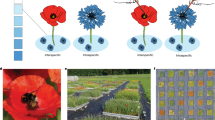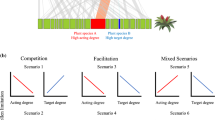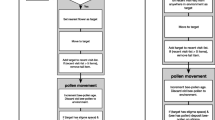Summary
Computer simulations of a pollinator foraging in a mixture of two species were used to explore how plant reproduction can be influenced by interspecific pollination movements. Interspecific pollen transfer led to strong competitive effects when availabilities of pollen, receptive stigma surfaces, or pollinator movements were limited relative to the total number of fertilizations possible in the mixed population. Results from simulations suggest that competition for pollination through interspecific pollen transfer can result in rapid exclusion of one of two species, and that such competition represents a selective force promoting stable divergence of potential competitors in habitat affinity, flowering time, or other characteristics related to pollinator sharing.
Similar content being viewed by others
References
Armitage, K.B.: Territorial behavior in fall migrant rufous hummingbirds. Condor 57, 239–240 (1955)
Augspurger, C.K.: The influence of population flowering synchrony on the individual plant's fruit and seed set. Bull. Ecol. Soc. Am. 58, 24–25 (abstract) (1977)
Britiain, W.H., Newton, D.E.: A study in the relative constancy of hive bees and wild bees in pollen gathering. Can. J. Res. 9, 334–349 (1933)
Clements, F.E., Long, F.L.: Experimental pollination—an outline of the ecology of flowers and insects. Carnegie Inst. Wash. Publ. No. 336 (1923)
Cruden, R.W.: Pollinators of high-elevation ecosystems: relative effectiveness of birds and bees. Science 176, 1439–1440 (1972)
Cruden, R.W.: Interspecific variation in pollen-ovule ratios and nectar secretion-preliminary evidence of ecotypic adaptation. Ann. Missouri Bot. Gard. 63, 277–289 (1976)
Cruden, R.W.: Pollen-ovule ratios: a conservative indicator of breeding systems in flowering plants. Evolution 31, 32–46 (1977)
Cruden, R.W., Kinsman, S., Stockhouse, R.E., Linhart, Y.B.: Pollination, fecundity, and the distribution of moth-flowered plants. Biotropica 8, 204–210 (1976)
Emlen, J.M.: Ecology: an evolutionary approach. Reading, Mass.: Addison-Wesley 1973
Feinsinger, P.: Organization of a tropical guild of nectariverous birds. Ecol. Monogr. 46, 257–291 (1976)
Free, J.B.: The foraging behavior of bees and its effect on the isolation and speciation of plants. In: Reproductive biology and taxonomy of vascular plants (J.G. Hawkes, ed.) pp. 76–91. Oxford: Pergamon Press 1966
Free, J.B.: Dandelion as a competitor to fruit trees for bee visits. J. Appl. Ecol. 5, 169–178 (1968)
Free, J.B.: The flower constancy of bumblebees. J. Anim. Ecol. 39, 395–402 (1970a)
Free, J.B.: Insect pollination of crops. London: Academic Press 1970b
Gilbert, L.E.: Ecological consequences of a coevolved mutualism between butterflies and plants. In: Coevolution of animals and plants (L.E. Gilbert, P.H. Raven, eds.), pp. 210–240. Austin: Univ. Texas Press 1975
Grant, V.: The flower constancy of bees. Bot. Rev. 16, 379–398 (1950)
Grant, V.: Grant, K.A.: Hummingbirds and their flowers. New York: Columbia Univ. Press 1968
Heinrich, B.: Bee flowers: a hypothesis on flower variety and blooming times. Evolution 29, 325–334 (1975)
Holling, C.S.: The components of predation as revealed by a study of small mammal predation of the European Pine Sawfly. Can. Entomol 91, 293–320 (1959)
Kislev, M.E., Kraviz, Z., Lorch, J.: A study of hawkmoth pollination by a palynological analysis of the proboscis. Israel J. Bot. 21, 57–75 (1972)
Lack, A.: Competition for pollination and evolution in Centaurea. New Phytol. 77, 787–792 (1976)
Levin, D.A.: The breeding system of Lithospermum caroliniense: adaptation and counteradaptation. Am. Nat. 102, 427–441 (1968a)
Levin, D.A.: The effect of corolla color and outline on interspecific pollen flow in Phlox. Evolution 23, 444–455 (1968b)
Levin, D.A., Anderson, W.W.: Competition for pollinators between simultaneously flowering species. Am. Nat. 104, 455–467 (1970)
Levin, D.A., Berube, D.E.: Phlox and Colias: the efficiency of a pollination system. Evolution 26, 242–250 (1972)
Levin, D.A., Kerster, H.W.: Gene flow in seed plants. Evol. Biol. 7, 139–220 (1974)
Lewis, H.: Experimental sympatric populations of Clarkia. Am. Nat. 95, 155–168 (1961)
Lyon, D.L.: Territorial and feeding activity of broad-tailed hummingbirds (Selasphorus platycercus) in Iris missouriensis. Condor 75, 346–349 (1973)
MacArthur, R.H.: Geographical ecology: patterns in the distribution of species. New York: Harper & Row 1972
Macior, L.W.: The pollination ecology of Pedicularis in Colorado. Am. J. Bot. 57, 716–728 (1970)
Mosquin, T.: Competition for pollinators as a stimulus for the evolution of flowering time. Oikos 22, 398–402 (1971)
Ornduff, R.: The reproductive system of Jepsonia heterandra. Evolution 25, 300–311 (1971)
Ornduff, R.: Pollen flow in Lythrum junceum, a tristylous species. New Phytol. 75, 161–166 (1975a)
Ornduff, R.: Heterostyly and pollen flow in Hypericum aegypticum (Guttiferae). Bot. J. Linn. Soc. 71, 51–57 (1975b)
Parrish, J.D., Bazzaz, F.A.: Niche differences in use of pollinators between plant species of an early successional community. Bull. Ecol. Soc. Am. 57, 35 (abstract) (1976)
Percival, M.S.: The presentation of pollen in certain anigosperms and its collection by Apis mellifera. New Phytol. 54, 353–368 (1955)
Perkins, M.D.C.: Dynamics of hummingbird mediated pollen flow in a subalpine meadow. M.S. Thesis, University of British Columbia, Vancouver, Canada (1977)
Pyke, G.H.: Studies in the foraging efficiency of animals. Ph. D. Dissertation, University of Chicago (1974)
Reader, R.J.: Competitive relationship of some bog ericads for major insect pollinators. Can. J. Bot. 53, 1300–1305 (1975)
Robertson, C.: The philosophy of flower seasons, and the phaenological relations of the entomophilous flora and the anthophilous insect fauna. Am. Nat. 29, 97–117 (1895)
Stiles, F.G.: Food supply and the annual cycle of the anna hummingbird. Univ. California Publ. Zool. No. 97 (1973)
Stiles, F. G.: Ecology, flowering phenology, and pollination of some Costa Rican Heliconia species. Ecology 56, 285–301 (1975)
Straw, R.M.: A Markov model for pollinator constancy and competition. Am. Nat. 106, 597–620 (1972)
Synge, A.D.: Pollen collection by honeybees (Apis mellifera). J. Anim. Ecol. 16, 122–138 (1947)
Waser, N.M.: Competition for pollination and the evolution of flowering time. Ph. D. Dissertation, University of Arizona, Tucson (1977)
Waser, N.M.: Competition for hummingbird pollination and sequential flowering in two Colorado wildflowers. Ecology (1978, in press)
Yeo, P.F.: Some aspects of heterostyly. New Phytol. 75, 147–153 (1975)
Author information
Authors and Affiliations
Rights and permissions
About this article
Cite this article
Waser, N.M. Interspecific pollen transfer and competition between co-occurring plant species. Oecologia 36, 223–236 (1978). https://doi.org/10.1007/BF00349811
Received:
Issue Date:
DOI: https://doi.org/10.1007/BF00349811




